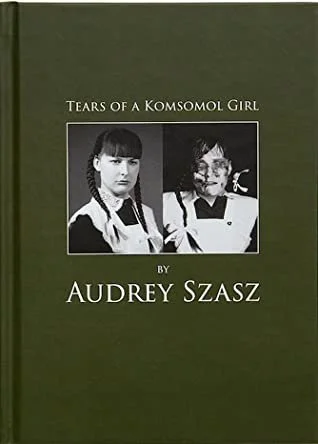Blood Red Flags: Tears of a Komsomol Girl by Audrey Szasz
Andrei Chikatilo was the Soviet Union's most notorious serial killer. Nicknamed “The Rostov Ripper,” he's estimated to have murdered over fifty women and children from 1978 until his arrest in 1990. He would not actually stand trial until after the dissolution of the Soviet Union, finally being executed in 1994.
Audrey Szasz's first full-length novel Tears of a Komsomol Girl is not immediately about Chikatilo, but he's a specter that haunts it the entire time. The novel revolves around a young girl named Arina, a teenager living in Rostov during the last years of the Soviet Union. She's a talented violinist, an excellent student, and a member of the Komsomol, the Youth Communist League. Despite the admiration she receives from her teachers and peers, she'd much rather wander the streets at night in search of cigarettes and alcohol and fraternize with soldiers and Communist Party bureaucrats. She sees her position as a means of finding a rich husband and living a life of luxury, despite spouting Party slogans every chance she gets.
Arina, however, is keenly aware of the Rostov Ripper stalking her city looking for victims. Throughout the novel, she contemplates his motivations, his known victims, and the possibility of coming face to face with him. These devolve into increasingly erratic and graphic fantasies of her own murder at the hands of Chikatilo.
Tears of Komsomol Girl does not tell a linear story. There are straightforward vignettes of Arina's life and past, but these will often meld with Arina's dreams and fantasies. Often, what is really happening to Arina and what's in her mind mix with no distinction. It's very much a subjective novel. It also shows Szasz's amazing skills as a writer. Her telling of Arina's life is engaging, hilarious, and recalls the decadent urban stories of Literary Brat Pack authors like Bret Easton Ellis and Tama Janowitz. This makes the story transitioning into stream of consciousness kaleidoscopes of violence and psychological symbolism all the more jarring, but in a way that really works. These parts are just as masterful.
Throughout the novel, Arina recalls being molested and assaulted by her parents and by other older men as a young child, making her behavior as a teenager unsurprising. It puts her fixation on the Rostov Ripper in a different light as well. Her past trauma makes her see the older men who abused her, and who wish to take advantage of her as a teenager, in Chikatilo. He's the ultimate archetype of an abuser, seeking to take everything from her for his own pleasure. Despite her atheism, she calls him “Satan,” viewing him as her platonic idea of evil.
References to Gorbachev and George HW Bush, as well as to increasing economic instability in the country, suggests that this novel takes place only a year or two before the dissolution of the USSR. Given the huge drop in living standards in the transition from the Soviet Union to the Russian Federation, one gets the impression that Arina would not have a bright future even if she never becomes a victim of Chikatilo. He could be viewed as symbolic of the rot within the Soviet Union, the corruption of officials and the concerns for international hegemony over those of Soviet citizens, and Arina as the common girl destined to be consigned to the dust bin of history
Tears of a Komosol Girl is an excellent first novel. It mixes the genres of true crime, coming of age, historical fiction, and surreaism in a seamless and unique way. Szasz's prose is excellent and vivid. Between this and her novelette Invisibility: A Manifesto, she's one of the most exciting newer writers I've come across. Highly recommended.
